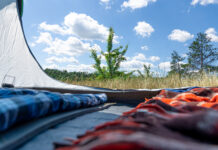Vibrant, energetic and poetic are the words that spring to mind at Susan Ossman’s On The Line painting exhibition. On first entering, dozens of oil on canvas pieces brighten the walls of La Sierra University’s Brandstater Gallery with fair blues, lustrous yellows and blooming pinks. Each painting is distinct yet tied to a common theme of clotheslines.
Yes, this is Ossman’s focus. As an artist and UCR professor of anthropology, her objective is interwoven with representation and a dialogue with human experience. She asserts in her artist statement that the exhibit is an investigation of all lines. This includes clotheslines that have been outlawed by many California housing developments, drawing removed from school curriculum and the disappearance of sentences in modern day. Expansive applications of color become sheets blowing in the wind. Squiggly lines become tangled threads. In effect, the exhibit is alive with color and movement, evoking thoughts on culture and the simple beauties of nature.
The show begins with a welcoming display of three paintings along the entryway wall entitled Binding, Tying Land to Sky and Boundaries (2010). Turquoise and orange paint create various organic shapes and lines in which interpretation is guided by the title and subtle hints of lines interacting with dominant patches of color. These set the tone for the rest of the show that follows in a loose and colorful approach. In the adjacent hallway and the gallery itself, paint is applied in a multitude of ways with thick sweeps paired with flowing gestures. Natural light from skylights also complimented the show. This interaction played along with the theme of clothes hanging outside in a nature-influenced environment.
The size of several of these painting was thrilling. The largest ran about 10 feet long and nine feet tall. It also seemed a popular approach for a single work to be composed of multiple canvases. This was the case for Caught In The Sheets (2012), an oil on canvas piece with massive pink, yellow and brown spaces unraveled by blue and chaotic pink lines. It is composed of six large canvases—three long and two wide—resting side by side. This method did not interrupt the work, but rather seemed to speak to the idea of clothes coming off lines just as paintings are hung and removed from walls. Placing several canvases beside one another was used again for the second largest work, Winter Wash, oil on four large canvases. Cold blues and black lines ebb from white sail-like shapes held in place by dashes of color representing clothespins. Here a lot of energy spurts from the rubbing of yellow and blue, suggesting outside forces are commanding these forms, perhaps something more than wind and weather.
With such an overarching theme and similar technique in the work, there were certainly pieces that stood out. The most distinct was in fact one of the few pieces that were not paintings. What Goes Unsaid (2010) is an installation of cloth, paper, ink and thread. Rather, it appeared to be five rectangular, gossamer bags containing torn up messages and hanging from the ceiling in the center of the room. This piece was a spectacle in its own right—fragile and light yet large-scale. It was appealing from distance and upon closer inspection, invited the viewer to read portions of the notes, or secret messages between women gossiping from “across backyard fences as they hang their clothes,” said Ossman. Aside from the two large paintings, several multi-media pieces were intriguing. Gather Wood, Gather Words: Arousa/ the Bride (2012) incorporated printed text into acrylic on canvas with a handful of paper strips bunched on the painting. The text echoed words in the title lending the piece a very poetic quality. Lineage (2013) did this too with bloodlines as the theme. “Blood blood blood…” and “lines lines lines…” ran about in print that was pasted to the work along with paper cutouts of clothespins floating about. Thus Ossman brought a variety of interpretations to line with clotheslines, bloodlines, written lines and lines in nature. In fact, from a distance, many of the pieces, especially Three Across (2012)—a three canvas painting with a dominant horizontal line from side to side—gave the impression of being topographical. However, unlike the others it also appeared to be an abstract timeline. Whether intentional or not, it still resonates with the theme.
Humor also hopped into pieces like Your Third Glass of Wine (2009), an oil on canvas painting with pink and red paint spilling out from circular shapes. Also, My Mother/Your Mother/What Color? (2013) is an installation in a corner with cloth and snipped sections of a poem about one mother punching the other in the nose. This lighthearted approach balanced some of the more abstract works, and provided a diversity that made the theme more accessible. But if you’re just looking for just good technique, the simple beauty of color and energetic application made the works appealing on an ascetic level. Tangled (2012) is an oil on canvas with royal blue, gold and black areas rippling together in messy lines at the base. It encourages thoughts of nature—the ocean and sand—as well as conflict with the dominating black sweeps.
While the work featured loose representations, vibrancy and hints toward lines as different materials made Ossman’s display enchanting. It had both an admirable quality to the technique of painting and to the meaning upon further inspection. Though communicating with our changing cultures and behaviors, the message is not preachy or harsh. Rather each painting seems inviting with its colors and poetic undertones. In all, the exhibit is whimsical, alluring and unfolds an entirely new and refreshing perspective on line in painting and in the world.








